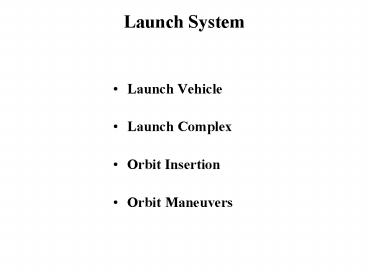Launch System - PowerPoint PPT Presentation
1 / 14
Title:
Launch System
Description:
Exterior skin with Propellant tanks within. Single stage. U.S. Launch Vehicles. Engine gimbals. Wall of tank and skin of vehicle one and the same. Multiple Stages ... – PowerPoint PPT presentation
Number of Views:63
Avg rating:3.0/5.0
Title: Launch System
1
Launch System
- Launch Vehicle
- Launch Complex
- Orbit Insertion
- Orbit Maneuvers
2
Booster Design
- German V-2
- Fins for stability and steering
- Exterior skin with Propellant tanks within
- Single stage
- U.S. Launch Vehicles
- Engine gimbals
- Wall of tank and skin of vehicle one and the
same - Multiple Stages
3
Launch Vehicles
Expendable Air Force and commercial US
systems Divided into small, medium, and heavy
classes Next generation of expendable vehicles in
development Manned Space Shuttle Reusable Test
vehicles only
4
Launch Ranges
Launch ranges provide tracking, telemetry,
communications, command control, and other
support necessary for safe and successful space
lift operations, and aeronautical and ballistic
missile tests.
5
Launch Fundamentals Launch Events
Step 7 Mechanical deployments
Shroud Protects the spacecraft
Step 6 Satellite initial checkout
Upper stage Orbit insertion rocket engines and
propellant tanks
Step 5 Orbit insertion
Step 4 Shroud opening
Step 3 Main engine cut-off and separation
Main vehicle Primary liquid or solid rocket
propellant tanks
Booster packs Solid strap-ons for some rockets to
increase initial thrust
Step 2 Booster cut-off and separation
Step 1 Ignition and launch
Engine / nozzles Mechanism for combining
propellants and focusing thrust
6
Usual Launch Sequence
7
Launch Ranges
Ranges usually located to minimize overflight
of populated areas and reduce potential
debris hazards Launch site latitude limits
the inclination of the satellites orbit The
minimum inclination of the orbit is equal to the
latitude of the launch site To get to a lower
inclination, satellites need to go through an
orbit plane transfer
8
DOD LAUNCH LOCATIONS
- CAPE CANAVERAL AFS / KENNEDY SPACE CENTER
- (EASTERN SPACE LAUNCH RANGE)
- SHUTTLE
- TITAN IV
- TITAN II
- ALTAS
- DELTA
- VANDENBURG AFB
- (WESTERN SPACE LAUNCH RANGE)
- TITAN IV
- TITAN II
- ALTAS
- DELTA
37 DEG
SPACE LAUNCH AZIMUTH
30 DEGREES LATITUDE
112 DEG
201 DEG
SPACE LAUNCH AZIMUTH
158 DEG
9
Launch Window
The launch window is the period of time during
which the launch must occur to achieve a desired
orbit Duration of window is determined by
desired orbit, launch location, weather, and
launch vehicle performance Examples of issues
Vehicle may require specific orbit for
rendezvous Vehicle may require orientation to get
correct solar array exposure before reaching
final orbit
10
Launch FundamentalsScience
force (mass) x (acceleration) f
(m)(a) The thrust of a launch vehicle must oppose
gravity and atmospheric drag To get into orbit, a
vehicle must achieve a velocity of mach 24 (24
times the speed of sound)
FORCE FORCE TIME FORCE TIME FUEL
Thrust Pounds or Kg Impulse Pounds per
sec Specific Impulse (Isp) Newtons per sec
Isp Thrust (lb)
fuel weight (lb) burned in 1 sec
11
Mass Ratio of a Vehicle
Mass Ratio (MR) is the ratio between the booster
mass before the rocket engine burn (mf ) divided
by the booster mass after rocket engine burn (m0
).
12
PROPULSION GETTING INTO AND AROUND IN ORBIT
NORTH POLE
ORBIT PLANE TRANSFER (WITH VECTOR THRUST BURN)
LAUNCH INTO PARKING ORBIT (WITH ORBIT INSERTION
BURN)
NORTH POLE
NORTH POLE
HOHMANN (MINIMUM ENERGY) TRANSFER (BURN 1 TO
CHANGE TO ELLIPTICAL ORBIT AND BURN 2 TO CHANGE
TO HIGHER ALTITUDE CIRCULAR ORBIT)
FAST TRANSFER (BURN 1 TO CHANGE TO LARGE ELLIPSE
AND BURN 2 TO FORCE INTO NEW ORBIT)
13
Launch from Vandenberg
- Launch site latitude 37 deg N latitude
- Desired Orbits
- Inclination 80 degrees 104 degrees
- Apogee 250 NM 250 NM
- Perigee 100 NM 100 NM
- What is the launch azimuth for each orbit?
- What velocity (V) must the payload have in each
desired orbit at perigee and apogee?
14
Launch Azimuth
cos Inclination cos Latitude x sin
Azimuth sin Azimuth cos Inclination/cos
Latitude Posigrade Orbit, i.e., with Earths
rotation sin Az cos 80/cos 37 sin 12.56
degrees Launch Azimuth 167.44
degrees Retrograde Orbit, i.e., against
Earths rotation sin Az cos 104/cos 37 sin
-17.63 degrees Launch Azimuth 197.63 degrees
North
167
198
Formula from page 81 Space Handbook, Analysts
Guide.































